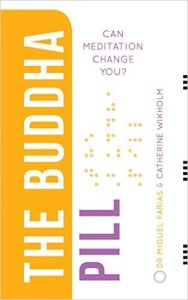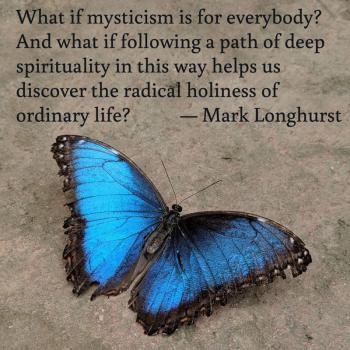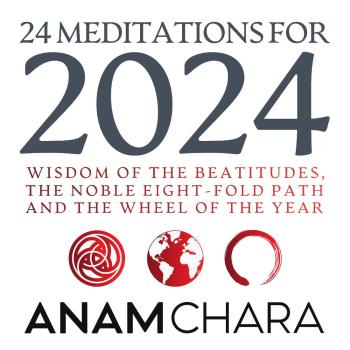
Is contemplation dangerous? Some people think so.
This past weekend I read a book that has given me some food for thought on this subject. The Buddha Pill: Can Meditation Change You? is by Miguel Farias and Catherine Wikholm, two psychologists in England who study the idea that practices like yoga or mindfulness meditation have observable health benefits. They became involved in a study of prisoners practicing yoga — could it help them to be more at peace, or even less aggressive?
As they surveyed the scientific literature on measurable effects of meditation and yoga, Farias and Wikholm discovered that much of the research was poorly executed or subject to ambiguous interpretations. Furthermore, it seemed like many of the studies were sponsored by organizations with an interest in promoting meditation.
The Buddha Pill seems very balanced in its approach, carefully describing ways in which various studies can be interpreted to demonstrate the positive benefits of spiritual practice — but also how much of the research has led to ambiguous or inconclusive results. Media coverage, however, tends only to stress the positive evidence — it’s almost as if we have a cultural desire to believe these kinds of practices can make a measurable difference in our lives, so much so that we are willing to ignore evidence that suggests otherwise.
But as interesting as its critique of “meditation science” is, what really grabbed me in reading The Buddha Pill was a chapter provocatively titled “The Dark Side of Meditation.”

The authors provide several anecdotal examples of people who experienced severe episodes of depression or even psychosis in the wake of engaging in intensive meditative practice. The chapter begins with the terrifying story of Aaron Alexis, a meditation practitioner who killed a dozen people at the Washington Navy Yard in 2013.
Farias and Wikholm go on to describe a 1992 study on the effect of meditation retreats, which “found that 63 per cent of [the subjects] had at least one negative effect and 7 per cent suffered profoundly adverse effects. The negative effects included anxiety, panic, depression, increased negativity, pain, feeling spaced out, confusion and disorientation.”
Wow.
We can dismiss stories like these by insisting that those who suffer negative effects from meditation must have had a pre-existing mental illness. But if meditation can make a mentally ill person worse, doesn’t that make meditation dangerous?
Maybe “dangerous” is not the best word here. I think a better word is “powerful.” Silence has the power to change us. Which means it is worthy of our respect.
With Aaron Alexis in mind, the Anglican solitary Maggie Ross wryly noted in her book Silence: A User’s Guide:
It is possible to practice meditation under the illusion that one is outside of any perceived value system, but this idea is deceptive and dangerous: meditation will intensify whatever values a person holds, whether or not they are acknowledged— and every person has a value system, positive or negative, creative or destructive. Meditation can be abused as well as used: One can meditate in order to become a more efficient killer.
Thirty years ago, I took my first class on “Christian meditation” — what we now would call silent prayer or centering prayer — while living in Washington, DC. When I signed up for the course, the application form explicitly stated that this course was not a form of therapy, and might not be appropriate for some persons based on their therapeutic needs. At the time, I remember thinking that meditation must be something powerful, something we should treat with respect.
I think that’s an important point we need to remember today, but maybe sometimes it gets lost in the “rah-rah” rhetoric of many meditation-boosters.
I’m not writing this blog post to scare anyone away from silent prayer, which I still believe is a profoundly beautiful, meaningful, and traditional way for fostering deep intimacy with God. Books like Centering Prayer and Inner Awakening or Centering Prayer and the Healing of the Unconscious have addressed the question of how to manage powerful emotions that might arise in the context of prayerful silence. So there are good resources available to help us when we encounter the power of silent prayer.
My purpose is simply to emphasize that contemplation — contemplative, silent prayer — is not something to be taken lightly.
Anything with the power to transfigure us from the inside out deserves our respect.
Here’s an interesting perspective from a friend of mine that I posted on Twitter a while back:
Is contemplative prayer dangerous? Yes! It’s dangerous the way Jesus is dangerous. — Kevin Johnson @johnsoxo
— Carl McColman (@CarlMcColman) May 17, 2015
Contemplative practice is like a power tool. If you know how to use it properly and carefully, it can make your “work” (in this case, the work of responding to the love of God) easier. But if used carelessly or improperly, it can be dangerous. When we pray in this way, we need our prayer to be grounded in the love and mercy of God. Otherwise, when we encounter the “icky stuff” deep inside us — our shadow, our sin, our fears and narcissism — it could seem overwhelming.
If you experience deep emotional distress as a result of any kind of meditative practice, immediately stop the practice, take care of yourself (avoid drugs and alcohol, don’t do anything to hurt yourself or anyone else, and ask someone you trust for help) and then seek out the care of a qualified mental health professional. This is not optional. Just like you can’t play sports if you aren’t willing to have a doctor treat you for injuries, likewise if you want to swim in the deep waters of contemplation you need to be willing to seek out appropriate mental health care, should the need arise.
I believe that the risk of this kind of emotional crisis is probably very low for those who engage in contemplative prayer or other forms of meditation for less than an hour per day. After all, the scary statistics in The Buddha Pill pertain to people who engage in intensive, multi-day meditation retreats. But no matter how low the risk may be, we need to be prepared to respond appropriately, should the need arise.
How to practice silent prayer safely
If you are interested in the practice of Christian silent prayer, here are five important steps to take to make sure your practice is spiritually safe.
- Meet regularly with a spiritual director or companion. In other words, you need someone with whom you can discuss your spiritual practice, honestly and candidly. Someone who will help you discern what’s going on if something unsettling or awe-inspiring occurs. This person will help you stay grounded and will keep you humble. And — this is difficult, but important — a good spiritual companion will help us see if we’ve gotten off track with our prayer or other spiritual practice (for example, if your spirituality is making you anxious or proud, instead of humble and compassionate).
- Actively participate in some sort of faith community. That could be a centering prayer group, an oblate or third order gathering, or even your church — but it needs to be a community of people with whom you are regularly engaged, who can answer your questions, encourage you when times are tough, or can provide a larger spiritual context for your practice.
- Maintain a daily vocal/verbal prayer practice, aside from the silence, that will help to form or deepen your spiritual values. As a Lay Cistercian, naturally I recommend praying some form of the Daily Office (see this blog post for more on that). Lectio Divina (prayerful Bible reading) is another option. The point here is to remember that in addition to immersion in silence, we need to be formed by the words, language and values of our spiritual tradition in order to become truly wise — and holy. Speaking of which…
- Commit yourself to becoming holy (by God’s grace). The purpose of Christian contemplation is not happy feelings or cool experiences, but holiness — that is to say, radical intimacy with God which will transfigure you from the inside out. In other words, practicing silent prayer or contemplation requires not just a desire to be still (as worthy as that may be), but also a larger spiritual context. For Christians, this means responding to the love of God. We are called not just to be mystics or contemplatives, but to be holy — to orient our lives to love and service and mercy. Silent prayer means more than just becoming peaceful or serene — it needs to be part of an overall life committed to becoming humble, compassionate, contrite (willing to turn away from sin) and loving — as Christ loved.
- Stay grounded: balance your interior work with good old fashioned “exterior” work. There’s a reason why Benedictine monks have as their motto Ora et Labora, which means “prayer and work.” Physical labor is a meaningful and valuable way to keep the body strong, and the mind focused on something other than its own interior drama. Even a task as simple as mowing the lawn or mopping the floor can help us remain grounded and stable. Kahlil Gibran said “Work is love made visible” — likewise, labora is ora made visible.
My sense, based on what I’ve seen over the past thirty years (and the mistakes I’ve made along the way) is that when we do these five things, we have the spiritual and social support to go as deep as possible in contemplative prayer safely and beautifully.
So is contemplative prayer dangerous? Yes, but just like a car or a chainsaw is dangerous. That doesn’t mean we shouldn’t use it, but it does mean we need to engage with it in a careful, respectful, and proper way. But when we do that, then we are in a position to be blessed by its power.
Enjoy reading this blog?
Click here to become a patron.
Do you have any other thoughts about how to practice silent prayer safely and responsibly? If so, please leave a comment below (or on social media).














